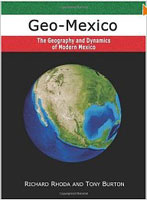Our grateful thanks to Felisa Churpa Rosa Rogers for the following review which appeared in The People’s Guide to Mexico, March 2011:
Growing up in a parochial school system, I was under the impression that the subject geography was limited to identifying countries by their shapes. Richard Rhoda and Tony Burton’s Geo-Mexico: The Geography and Dynamics of Modern Mexico drove the last nail in the coffin of my childhood misconception. Although it has its share of maps, the volume illustrates both the richness of geography as a field of study and the spectrum of cultural, economic, and environmental anomalies that make Mexico so eternally fascinating.
 Due to its format and content, Geo-Mexico: The Geography and Dynamics of Modern Mexico is essentially a text book, albeit a rather excellent one. Don’t let that deter you. Although packed with interesting statistics, this book has more to offer: the authors are unafraid to make concrete assertions without miring their observations in academic qualifiers. Burton and Rhoda state facts in a fresh style, provide compelling statistics, and clearly explain all terms and concepts.
Due to its format and content, Geo-Mexico: The Geography and Dynamics of Modern Mexico is essentially a text book, albeit a rather excellent one. Don’t let that deter you. Although packed with interesting statistics, this book has more to offer: the authors are unafraid to make concrete assertions without miring their observations in academic qualifiers. Burton and Rhoda state facts in a fresh style, provide compelling statistics, and clearly explain all terms and concepts.
Every time a boring-sounding chapter title had me contemplating skipping ahead, I’d find a gem that kept me reading. For example, the chapter “Transportation: The Movement of People and Goods” drew me in with a tidbit about the transportation of silver bullion from Zacatecas in the 16th Century. I was glad I persevered because I stumbled across a fascinating segment on the cultural exchange between the Philippines and Mexico, which began in 1565 when Spain established an import route from The Philippines that crossed Mexico, shipping in at Acapulco and out again at Veracruz.
“..Spanish galleons carried Mexican silver to Manila and returned with spices, silk, porcelain, lacquer ware and other exotic goods from the Orient. ..Many Mexicans settled in Manila and a sizable Filipino community was established in Acapulco. Scores of Nahuatl words entered Tagalog, the main Filipino language. The Filipino currency is still called the peso. In the return direction, Filipinos taught Mexicans the distillation process which enabled the production of tequila.”
If history isn’t your game, Rhoda and Burton provide hard data on immigration, crime, population growth, the effects of NAFTA, ecosystems, and tourism’s impact on the environment. Because I write about Mexico, I will treasure Geo-Mexico: The Geography and Dynamics of Modern Mexico as a resource, but I highly recommend this volume to educators, students, and anyone with more than a passing interest in the culture, history, terrain, economy, politics, or development of the country.
[The People’s Guide to Mexico, March 2011]
Sorry, the comment form is closed at this time.